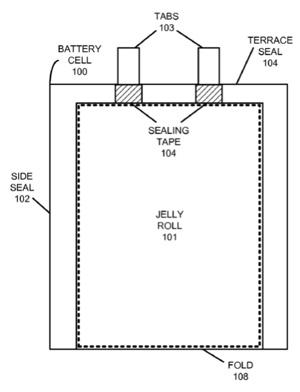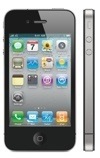A new Apple patent (number 20110123844) shows that Apple is eyeing ways to improve battery life in its laptops and iOS devices via a battery with multiple “jelly rolls” enclosed in a single pouch.
Disclosed embodiments in the patent — entitled “pressure-relief mechanism to improve safety in lithium-polymer battery cells” — relate to a battery cell which includes a weakness for relieving pressure. This battery cell includes a jelly roll comprising layers which are wound together, including a cathode with an active coating, a separator and an anode with an active coating. The jelly roll also includes a first conductive tab coupled to the cathode and a second conductive tab coupled to the anode. The jelly roll is enclosed in a flexible pouch, wherein the first and second conductive tabs extend through seals in the pouch to provide terminals for the battery cell.
This pouch includes a weakness which yields when internal pressure in the pouch exceeds a threshold to create a hole which releases the internal pressure. The inventors are Ramesh C. Bhardwaj, Taisup Hwang, and Richard M. Mank.
Here’s Apple’s background and summary of the invention: “Rechargeable batteries are presently used to provide power to a wide variety of portable electronic devices, including laptop computers, cell phones, PDAs, digital music players and cordless power tools. The most commonly used type of rechargeable battery is a lithium battery, which can include a lithium-ion or a lithium-polymer battery.
“A potential safety issue can arise if there is a gas buildup within a rechargeable lithium battery cell. This can occur, for example, if the cell is overcharged, if there is a short within the cell, or if the cell is left uncharged for a significant period of time. This type of gas buildup can potentially cause the battery cell to swell or even to explode, which can seriously damage the portable electronic device, and may even start a fire.
“To alleviate this problem, cylindrical lithium-ion battery cells are often equipped with a vent valve to release the internal pressure in the battery cell when a gas buildup occurs. However, there exist no comparable pressure-relief mechanisms for lithium-polymer batteries, which are becoming increasingly popular in portable electronic devices. A lithium-polymer battery is typically enclosed in a flexible pouch, which is lightweight and inexpensive to manufacture. However, no pressure-relief mechanism has been developed for these pouches so far.
“The disclosed embodiments relate to a battery cell which includes a weakness for relieving pressure. This battery cell includes a jelly roll comprising layers which are wound together, including a cathode with an active coating, a separator, and an anode with an active coating. The jelly roll also includes a first conductive tab coupled to the cathode and a second conductive tab coupled to the anode.
“The jelly roll is enclosed in a flexible pouch, wherein the first and second conductive tabs extend through seals in the pouch to provide terminals for the battery cell. This pouch includes a weakness which yields when internal pressure in the pouch exceeds a threshold to create a hole which releases the internal pressure.
“In some embodiments, the pouch includes multiple weaknesses at different locations on the pouch. In some embodiments, the weakness can include: a V-shaped notch cut into a seal for the pouch; a half-circle cut into a seal for the pouch; a pattern of tiny holes formed in a seal for the pouch; and a thinned region of the pouch material.
“In some embodiments, the weakness can be located on: a side seal for the pouch; a terrace seal for the pouch; a corner of the pouch; a fold in the pouch material; and a location on a surface of the pouch which is not part of a seal.
“In some embodiments, the pouch is comprised of a layer of aluminum and a layer of polypropylene. In some embodiments, the battery cell is a lithium-polymer battery cell, or a silver-zinc battery cell.”
— Dennis Sellers




